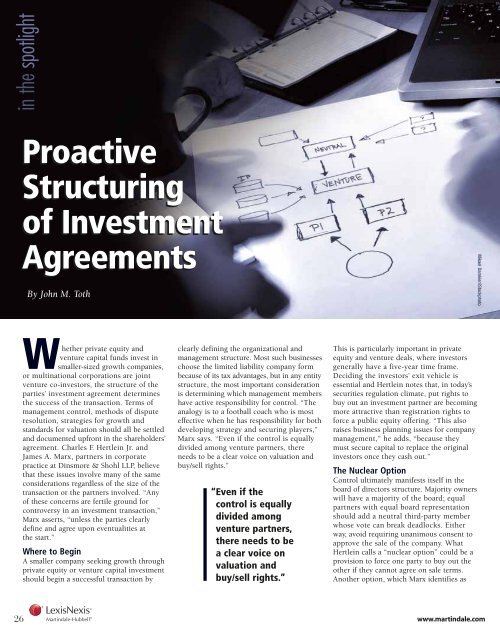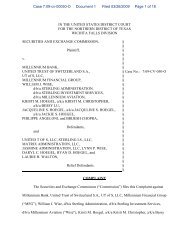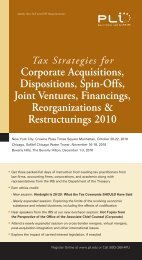View the full text of this document - Martindale.com
View the full text of this document - Martindale.com
View the full text of this document - Martindale.com
Create successful ePaper yourself
Turn your PDF publications into a flip-book with our unique Google optimized e-Paper software.
in <strong>the</strong> spotlight<br />
Proactive<br />
Structuring<br />
<strong>of</strong> Investment<br />
Agreements<br />
By John M. Toth<br />
Mikael Damkier/iStockphoto<br />
Whe<strong>the</strong>r private equity and<br />
venture capital funds invest in<br />
smaller-sized growth <strong>com</strong>panies,<br />
or multinational corporations are joint<br />
venture co-investors, <strong>the</strong> structure <strong>of</strong> <strong>the</strong><br />
parties’ investment agreement determines<br />
<strong>the</strong> success <strong>of</strong> <strong>the</strong> transaction. Terms <strong>of</strong><br />
management control, methods <strong>of</strong> dispute<br />
resolution, strategies for growth and<br />
standards for valuation should all be settled<br />
and <strong>document</strong>ed upfront in <strong>the</strong> shareholders’<br />
agreement. Charles F. Hertlein Jr. and<br />
James A. Marx, partners in corporate<br />
practice at Dinsmore & Shohl LLP, believe<br />
that <strong>the</strong>se issues involve many <strong>of</strong> <strong>the</strong> same<br />
considerations regardless <strong>of</strong> <strong>the</strong> size <strong>of</strong> <strong>the</strong><br />
transaction or <strong>the</strong> partners involved. “Any<br />
<strong>of</strong> <strong>the</strong>se concerns are fertile ground for<br />
controversy in an investment transaction,”<br />
Marx asserts, “unless <strong>the</strong> parties clearly<br />
define and agree upon eventualities at<br />
<strong>the</strong> start.”<br />
Where to Begin<br />
A smaller <strong>com</strong>pany seeking growth through<br />
private equity or venture capital investment<br />
should begin a successful transaction by<br />
clearly defining <strong>the</strong> organizational and<br />
management structure. Most such businesses<br />
choose <strong>the</strong> limited liability <strong>com</strong>pany form<br />
because <strong>of</strong> its tax advantages, but in any entity<br />
structure, <strong>the</strong> most important consideration<br />
is determining which management members<br />
have active responsibility for control. “The<br />
analogy is to a football coach who is most<br />
effective when he has responsibility for both<br />
developing strategy and securing players,”<br />
Marx says. “Even if <strong>the</strong> control is equally<br />
divided among venture partners, <strong>the</strong>re<br />
needs to be a clear voice on valuation and<br />
buy/sell rights.”<br />
“Even if <strong>the</strong><br />
control is equally<br />
divided among<br />
venture partners,<br />
<strong>the</strong>re needs to be<br />
a clear voice on<br />
valuation and<br />
buy/sell rights.”<br />
This is particularly important in private<br />
equity and venture deals, where investors<br />
generally have a five-year time frame.<br />
Deciding <strong>the</strong> investors’ exit vehicle is<br />
essential and Hertlein notes that, in today’s<br />
securities regulation climate, put rights to<br />
buy out an investment partner are be<strong>com</strong>ing<br />
more attractive than registration rights to<br />
force a public equity <strong>of</strong>fering. “This also<br />
raises business planning issues for <strong>com</strong>pany<br />
management,” he adds, “because <strong>the</strong>y<br />
must secure capital to replace <strong>the</strong> original<br />
investors once <strong>the</strong>y cash out.”<br />
The Nuclear Option<br />
Control ultimately manifests itself in <strong>the</strong><br />
board <strong>of</strong> directors structure. Majority owners<br />
will have a majority <strong>of</strong> <strong>the</strong> board; equal<br />
partners with equal board representation<br />
should add a neutral third-party member<br />
whose vote can break deadlocks. Ei<strong>the</strong>r<br />
way, avoid requiring unanimous consent to<br />
approve <strong>the</strong> sale <strong>of</strong> <strong>the</strong> <strong>com</strong>pany. What<br />
Hertlein calls a “nuclear option” could be a<br />
provision to force one party to buy out <strong>the</strong><br />
o<strong>the</strong>r if <strong>the</strong>y cannot agree on sale terms.<br />
Ano<strong>the</strong>r option, which Marx identifies as<br />
26 www.martindale.<strong>com</strong>









